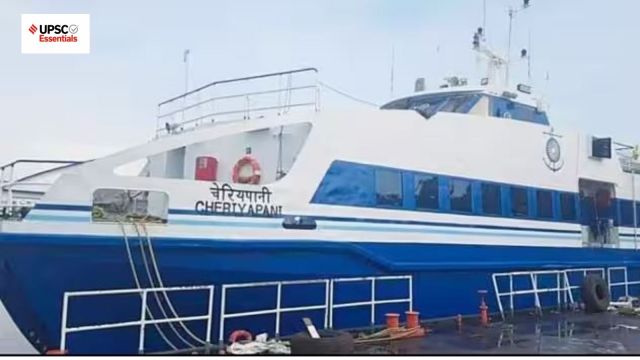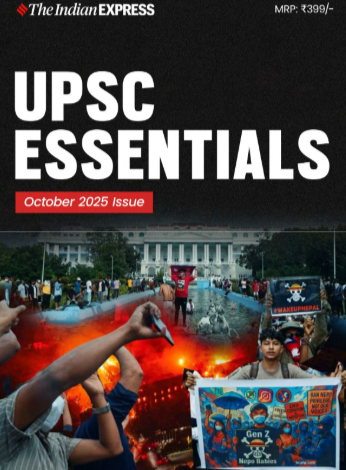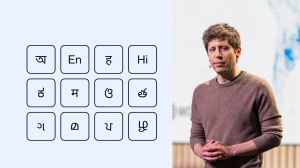Manas Srivastava leads the UPSC Essentials section of The Indian Express (digital). He majorly writes on UPSC, other competitive exams and education-related projects. In the past, Manas has represented India at the G-20 Youth Summit in Mexico. He is a former member of the Youth Council, GOI. A two-time topper/gold medallist in History (both in graduation and post-graduation) from Delhi University, he has mentored and taught UPSC aspirants for more than five years. His diverse role in The Indian Express consists of writing, editing, anchoring/ hosting, interviewing experts, and curating and simplifying news for the benefit of students. He hosts the YouTube talk show called ‘Art and Culture with Devdutt Pattanaik’ and a LIVE series on Instagram and YouTube called ‘LIVE with Manas’.His talks on ‘How to read a newspaper’ focus on newspaper reading as an essential habit for students. His articles and videos aim at finding solutions to the general queries of students and hence he believes in being students' editor, preparing them not just for any exam but helping them to become informed citizens. This is where he makes his teaching profession meet journalism. He is also the editor of UPSC Essentials' monthly magazine for the aspirants. He is a recipient of the Dip Chand Memorial Award, the Lala Ram Mohan Prize and Prof. Papiya Ghosh Memorial Prize for academic excellence. He was also awarded the University’s Post-Graduate Scholarship for pursuing M.A. in History where he chose to specialise in Ancient India due to his keen interest in Archaeology. He has also successfully completed a Certificate course on Women’s Studies by the Women’s Studies Development Centre, DU. As a part of N.S.S in the past, Manas has worked with national and international organisations and has shown keen interest and active participation in Social Service. He has led and been a part of projects involving areas such as gender sensitisation, persons with disability, helping slum dwellers, environment, adopting our heritage programme. He has also presented a case study on ‘Psychological stress among students’ at ICSQCC- Sri Lanka. As a compere for seminars and other events he likes to keep his orating hobby alive. His interests also lie in International Relations, Governance, Social issues, Essays and poetry. ... Read More
UPSC Essentials | Key terms of past week with MCQs and Points to ponder
Cheriyapani, foetal viability, electoral bonds, and more — here's a highlight of some of the important terms useful for UPSC CSE Prelims and Mains preparation.
 The vessel to be used as the ferry is called Cheriyapani and it can accommodate 150 passengers. Find more in the key terms today. (Twitter/@KRD_forum)
The vessel to be used as the ferry is called Cheriyapani and it can accommodate 150 passengers. Find more in the key terms today. (Twitter/@KRD_forum) Essential key terms from last week’s news headlines or beyond the headlines for the UPSC-CSE and other competitive exams. Let’s not just limit ourselves to facts. Dive deep to know:
1.What is the ‘vision document’ of India- Sri Lankan ties?
2. Why is the electoral bond scheme facing a legal challenge and what are its larger criticisms?
3. Has the court ever allowed termination of pregnancy beyond 26 weeks?
And more…
Cheriyapani
WHY IN NEWS?
— An age-old sea route between India and Sri Lanka has been rejuvenated with the inauguration of a passenger ferry service called Cheriyapani from Nagapattinam in Tamil Nadu to Kankesanthurai in Jaffna, Northern Sri Lanka.
KEY TAKEAWAYS
Arun Janardhanan Explains:
— The initiative is aimed at bolstering bilateral ties, boosting tourism, and increasing people-to-people relations. It is expected to benefit local traders on both shores.
— Maritime linkage between India and Sri Lanka isn’t new. The Indo-Ceylon Express or Boat Mail ran between Chennai and Colombo via the Thoothukudi port from the early 1900s up until 1982. However, the civil war in Sri Lanka resulted in the halting of these services.
— Before the civil war erupted, one of the most popular routes was from Dhanushkodi to Talaimannar. Passengers from Chennai would get onto the Boat Mail Express, a train from Chennai’s Egmore railway station, and then transfer to a coal-powered steam ferry in Dhanushkodi, which would take them to Talaimannar in roughly two hours.
— Maritime linkage between India and Sri Lanka isn’t new. The Indo-Ceylon Express or Boat Mail ran between Chennai and Colombo via the Thoothukudi port from the early 1900s up until 1982. However, the civil war in Sri Lanka resulted in the halting of these services.
— Before the civil war erupted, one of the most popular routes was from Dhanushkodi to Talaimannar. Passengers from Chennai would get onto the Boat Mail Express, a train from Chennai’s Egmore railway station, and then transfer to a coal-powered steam ferry in Dhanushkodi, which would take them to Talaimannar in roughly two hours.
— The resumption of ferry services has been on the cards for quite some time, especially after the war ended in 2009. A Memorandum of Understanding (MoU) concerning passenger transportation by sea was signed in 2011 and a similar service was launched. However, it did not last for more than six months due to poor response.
— Attempts were also made to establish services from Rameswaram to Talaimannar and Karaikal to Kankesanthurai. Various challenges kept these proposals from materialising.
— By providing a transportation option, the ferry can amplify religious tourism in the coastal regions of both countries. From India, travellers can access significant religious sites in Colombo and the southern parts of Sri Lanka. Indian pilgrim centres such as Nagapattinam, Nagore, Velankanni, Thirunallar, and temple towns such as Thanjavur, Madurai, and Tiruchi are expected to see an influx of Lankan tourists.
— Beyond religious tourism, the services would boost regional commerce and trade.
— The Nagapattinam port, under the Tamil Nadu Maritime Board, was upgraded recently with funds worth Rs 8 crore from the Union Ministry of External Affairs.
JUST FYI: The ‘vision document’ of India- Sri Lankan ties
— India and Sri Lanka in July 2023 adopted a ‘vision document’ for a deeper economic partnership after talks between Sri Lankan President Ranil Wickremesinghe and Prime Minister Narendra Modi.
— The ‘vision document’ adopted is based on five pillars: maritime connectivity; air connectivity; energy and power connectivity; trade, economic and financial connectivity, and people-to-people connectivity.
— On maritime connectivity, it outlines cooperation in development of ports and logistics at Colombo, Trincomalee and Kankesanthurai, with an aim to consolidate regional logistics and shipping. It also talks of resumption of passenger ferry services between Nagapattinam in India and Kankesanthurai in Sri Lanka besides working towards early resumption of ferry services between Rameshwaram and Talaimannar.
— The document also mentions expansion of flights between Chennai and Colombo, besides exploring connectivity between Chennai and Trincomalee, Batticaloa and other destinations in Sri Lanka. This will, according to the document, “encourage and strengthen investment and cooperation in civil aviation, including augmentation of airport infrastructure at Palaly for greater economic benefits to the people.”
— On energy and power connectivity, the two sides plan to “establish a high capacity power grid interconnection… to enable bidirectional electricity trade between Sri Lanka and other regional countries, including those of the BBIN (Bangladesh, Bhutan, India, Nepal) initiative. This has the potential to not only bring down the costs of electricity in Sri Lanka but also help create a valuable and dependable source of foreign exchange for Sri Lanka, the document said.
— The document also talks of expediting “implementation of understanding reached” on the Sampur Solar power project and LNG infrastructure, and exploring cooperation in Green Hydrogen and Green Ammonia.”
— The two countries will also be working on a multi-product petroleum pipeline from India’s South to Sri Lanka, besides undertaking a “mutually agreed” joint exploration and production of hydrocarbons in Sri Lanka’s offshore basins to develop Sri Lanka’s upstream petroleum sector.
— According to the document, the two sides will also “undertake discussions on the Economic and Technology Cooperation Agreement with an aim to comprehensively enhance bilateral trade and investments in new and priority areas.”
— According to the document, the “decision to designate Indian Rupee as currency for trade settlements between the two countries has forged stronger and mutually-beneficial commercial linkages”. It said both sides agreed to operationalise “UPI-based digital payments for further enhancing trade and transactions between businesses and common people”.
— The two sides also “agreed to leverage India’s Digital Public Infrastructure in accordance with Sri Lanka’s requirements and priorities towards effective and efficient delivery of citizen-centric services to the people of Sri Lanka”.
— The two countries also plan “to promote awareness and popularize India’s Buddhist circuit, and Ramayana trail as well as ancient places of Buddhist, Hindu and other religious worship in Sri Lanka for enhancing tourism”, besides exploring cooperation between educational institutions.
“To expand cooperation between research and academic institutes in areas of mutual interests such as agriculture, aquaculture, IT, business, finance and management, health and medicine, earth and marine sciences, oceanography, space applications, as well as history, culture, languages, literature, religious studies and other humanities,” the document said.
Point to ponder: Ports to UPI to green energy — How did India and Sri Lanka deepen economic ties in the recent past?
1. MCQ:
Consider the following statements and answer the question below:
1. There are 12 major ports and 200 non-major ports (minor ports) in the country.
2. Vision of the Sagarmala Program is to increase tourists’ footprints in India through maritime route.
3. The Indo-Ceylon Express or Boat Mail ran between Chennai and Colombo via the Thoothukudi port upto 2014.
How many statement/s above is/are correct?
(a) Only one of the statements.
(b) Only two statements.
(c) All three statements.
(d) None
Electoral bonds scheme
WHY IN NEWS?
— The Supreme Court said on Tuesday that it will hear petitions challenging the electoral bonds scheme on October 31. The 2018 scheme introduced instruments through which money could be donated to political parties in India.
— However, in April last year, the court had said it would take up the petitions filed by two NGOs — Common Cause and Association for Democratic Reforms (ADR) — challenging the scheme.
KEY TAKEAWAYS
What is the electoral bonds scheme?
— Announced in the 2017 Union Budget, electoral bonds are interest-free bearer instruments used to donate money anonymously to political parties. Simply put, anyone can donate money to political parties through them.
— Such bonds, which are sold in multiples of Rs 1,000, Rs 10,000, Rs 1 lakh, Rs 10 lakh, and Rs 1 crore, can be bought from authorised branches of the State Bank of India (SBI). As such, a donor is required to pay the amount — say Rs 10 lakh — via a cheque or a digital mechanism (cash is not allowed) to the authorised SBI branch.
— The political parties can choose to encash such bonds within 15 days of receiving them and fund their electoral expenses. There is no limit on the number of bonds an individual or company can purchase. If a party hasn’t enchased any bonds within 15 days, SBI deposits these into the Prime Minister’s Relief Fund.
What was the rationale behind the electoral bonds scheme?
— When first announced in then Finance Minister Arun Jaitley’s Budget speech of 2017, he had said, “Even 70 years after Independence, the country has not been able to evolve a transparent method of funding political parties which is vital to the system of free and fair elections…Political parties continue to receive most of their funds through anonymous donations which are shown in cash. An effort, therefore, requires to be made to cleanse the system of political funding in India.”
— Two main changes were proposed then:
1. It reduced the amount of money that a political party could accept in cash from anonymous sources — from Rs 20,000 to Rs 2,000.
2. He announced the introduction of electoral bonds as a way to make such funding more transparent.
— However, the fine print of the notification has revealed that even individuals, groups of individuals, NGOs, religious and other trusts are permitted to donate via electoral bonds without disclosing their details.
JUST FYI: Why is the scheme facing a legal challenge and what are its larger criticisms?
— According to a Livelaw report, the petitions have been filed by the Communist Party of India (Marxist), and NGOs Common Cause and ADR. They have challenged the scheme as “an obscure funding system which is unchecked by any authority”.
— Also, before the electoral bonds scheme was announced, there was a cap on how much a company could donate to a political party: 7.5 per cent of the average net profits of a company in the preceding three years. However, the government amended the Companies Act to remove this limit, opening the doors to unlimited funding by corporate India, critics argue.
— The petitioners said the amendments to the Companies Act 2013 will lead to “private corporate interests taking precedence over the needs and rights of the people of the State in policy considerations”.
— In general, critics argue that the anonymity of donors under the scheme further makes the process opaque instead of meeting its aim of bringing about transparency.
— It has been claimed that because such bonds are sold via a government-owned bank (SBI), it leaves the door open for the government to know exactly who is funding its opponents. This, in turn, allows the possibility for the government of the day to either extort money, especially from the big companies or victimise them for not funding the ruling party — either way providing an unfair advantage to the party in power.
— Critics such as Anjali Bhardwaj, co-convenor of the National Campaign for People’s Right to Information, have noted that more than 75 per cent of all electoral bonds have gone to the BJP, which is in power at the Centre.
— Further, one of the arguments for introducing electoral bonds was to allow common people to easily fund political parties of their choice but more than 90% of the bonds have been of the highest denomination (Rs 1 crore) as of 2022.
Point to ponder: Why is the electoral bond scheme being opposed by transparency activists?
2. MCQ:
What is ‘SVEEP’?
(a) It is the flagship program of the Election Commission of India for voter education.
(b) It is a regulatory project of the Election Commission of India to identify and de-register inactive political parties.
(c) It is an initiative by the Election Commission of India to ensure transparency in the electoral bond scheme.
(d) None of the above.
Foetal viability
WHY IN NEWS?
— Two specific ideas have come up during the SC hearings of a married woman’s request for ending her 26-week pregnancy , which are vital in discussions around abortion, but which are not usually taken up in India: “foetal viability”, and the rights of the unborn child.
KEY TAKEAWAYS
Apurva Vishwanath Explains:
What is this case about?
— A 27-year-old married woman, who already has two sons, has pleaded that the current pregnancy was unplanned. She has said that her family income is insufficient to support another child, and that she is herself not in the right mental frame, having been under medication for post partum depression after the birth of her second child.
— On October 9, a two-judge Bench of Justices Hima Kohli and B V Nagarathna, after interacting with the petitioner through video conferencing, allowed the termination of the pregnancy. The court reasoned that an unwanted pregnancy due to failure of contraceptive methods is the same as a forced pregnancy for which termination is allowed up to 24 weeks.
— However, on October 10, a doctor from AIIMS, Delhi, the hospital where the woman was to go for the procedure, emailed the counsel for the Centre saying that a directive would be needed from the SC on whether a foeticide (stopping the foetal heart) can be done before the termination of the pregnancy, since the foetus is “currently viable” and presents a “strong possibility of survival”.
— On October 11, after the AIIMS report, the same SC Bench was split on allowing the abortion. Justice Nagarathna said the petitioner’s decision to abort must be respected, while Justice Kohli said her “judicial conscience” did not permit her to accept the request.
— The case then went before a three-judge Bench headed by Chief Justice of India (CJI) D Y Chandrachud. On Friday (October 13), the Bench called for a fresh medical report to indicate the foetal health and medical condition of the woman. The case will come up again before the court on October 16.
— The Supreme Court on October 16 declined permission to a married woman to terminate her over 26-week pregnancy, saying the AIIMS medical board had found “no substantial foetal abnormalities” and a pre-term delivery carried the risk of being born with physical and mental deformities.
What is India’s law on abortion?
— The Medical Termination of Pregnancy Act (MTP Act) allows termination of pregnancy in three stages.
1) Termination of pregnancy up to 20 weeks is allowed on the advice of one doctor.
2) If a pregnancy is 20-24 weeks, the right to seek abortion is determined by two registered medical practitioners as an exception, but only under certain categories. Section 3B of the Rules under the MTP Act lists seven categories of forced pregnancies, including statutory rape in case of minors or sexual assault; women with disabilities; or when there is a change in marital status of women during pregnancy.
3) After 24 weeks, the MTP Act requires a medical board to be set up in “approved facilities”, which may “allow or deny termination of pregnancy” only if there is substantial foetal abnormality.
Where do the ideas of the rights of an unborn child, and foetal viability come in?
— The observations by the CJI-led Bench on October 13 oscillated between the rights of a woman “must trump” when it comes to abortion, and the need to “balance out the rights of the unborn child”.
“There is no doubt that our law is far ahead of other countries. We will not have a ‘Roe versus Wade’ situation here. Our law is liberal and pro-choice,” the CJI observed.
— While courts have read the MTP Act liberally, the test of “foetal viability” as a benchmark to allow abortion is new in India. The landmark 1973 US Supreme Court verdict in ‘Roe v Wade’ that made abortion a constitutional right allowed abortion up to the point of foetal viability, that is, the time after which a foetus can survive outside the womb.
— Foetal viability in 1973 was pegged at 28 weeks (7 months), which is now with scientific advancement lower at 23-24 weeks (6 months). It has been argued, therefore, that foetal viability is an arbitrary standard.
— The criticism of India’s law is that the decision to terminate after 20 weeks is shifted to doctors and not the woman. While this aspect is not challenged in court, frequent cases of women approaching the court at the eleventh hour point to a legislative gap.
— The Indian legal framework on reproductive rights tilts to the side of the woman’s autonomy to decide and choose more than towards the rights of the unborn child.
— In 2005, Rajasthan High Court in ‘Nand Kishore Sharma versus Union of India’ rejected a challenge to the constitutional validity of the MTP Act on the grounds that it violates the fundamental right to life of an unborn child.
— The right of an unborn child has, however, formed the basis of legislation that deal with succession or the law banning sex-determination of foetus. Section 416 of the Code of Criminal Procedure also provides for postponement of the death sentence awarded to a pregnant woman.
JUST FYI: Has the court allowed termination beyond 26 weeks?- YES
— On August 21, a Bench headed by Justice Nagarathna held a special sitting on a Saturday (when the court is shut) to allow termination of pregnancy of a rape survivor whose pregnancy was at 27 weeks and three days.
— However, the difference in the current case seems to be the marital status of the woman, which indicates that the conception is consensual and not a “forced” pregnancy in the way it is usually understood.
— In September 2022, a Bench led by Justice Chandrachud (he was not CJI at the time) allowed abortion for an unmarried woman who was 24 weeks pregnant, and was in a consensual relationship. The Bench cited “transformative constitutionalism” that promotes and engenders societal change, and said that “the law must remain cognizant of the fact that changes in society have ushered in significant changes in family structures”.
— There are also instances in which a court has overruled the decision of the medical board to allow termination. In ‘Bhatou Boro v. State of Assam’ (2017), Gauhati High Court overruled the medical board’s refusal to give an opinion for termination of pregnancy of over 26 weeks of a minor rape survivor.
Point to ponder: On reproductive rights, India’s MTP and Surrogacy Acts don’t go far enough. Do you agree?
3. MCQ:
With reference to Medical Termination of Pregnancy Act, consider the following statement:
1) Termination of pregnancy up to 20 weeks is allowed on the advice of one doctor.
2) If a pregnancy is 20-24 weeks, the right to seek abortion is determined by two registered medical practitioners as an exception, but only under certain categories.
3) After 24 weeks, the MTP Act requires a medical board to be set up in “approved facilities”, which may “allow or deny termination of pregnancy” only if there is substantial foetal abnormality.
Which of the above statement/s is/are incorrect?
(a) Only 1
(b) Only 2 and 3
(c) Only 1 and 3
(d) None
Habitat rights
WHY IN NEWS?
— The Baiga Particularly Vulnerable Tribal Group (PVTG) Monday became the second to get habitat rights in the state, after the Kamar PVTG on August 9.
— The Baiga community primarily resides in Rajnandgaon, Kawardha, Mungeli, Gaurela-Pendra-Marwahi (GPM), Manendra-Bharatpur-Chirmiri, and Bilaspur districts of the state. The community also lives in the adjacent districts of Madhya Pradesh.
KEY TAKEAWAYS
Jayprakash S Naidu Explains:
What are habitat rights?
— Habitat rights recognition provides the community concerned rights over their customary territory of habitation, socio-cultural practices, economic and livelihood means, intellectual knowledge of biodiversity and ecology, traditional knowledge of use of natural resources, as well as protection and conservation of their natural and cultural heritage.
— Habitat rights safeguard and promote traditional livelihood and ecological knowledge passed down through generations. They also help converge different government schemes and initiatives from various departments to empower PVTG communities to develop their habitats.
What does ‘habitat’ mean, under what law are such rights granted?
— Habitat rights are given to PVTGs under section 3(1) (e) [rights including community tenures of habitat and habitation for primitive tribal groups and pre-agricultural communities] of The Scheduled Tribes and Other Traditional Forest Dwellers (Recognition of Forest Rights) Act, 2006 also known as the Forest Rights Act (FRA).
— According to Section 2(h) of FRA, “Habitat includes the area comprising the customary habitat and such other habitats in reserved forests and protected forests of primitive tribal groups and pre-agricultural communities and other forest dwelling Scheduled Tribes.”
Can habitat rights be used to stop activities like mining?
— Shomona Khanna, an advocate at the Supreme Court of India and former legal advisor to the Union Ministry of Tribal Affairs, said, “Of course, the habitat rights will help the PVTG protect their habitat from developmental activities harmful to them. The title may not be an ownership title in the nature of a private property owner, but consent and consultation of the gram sabha will be needed for any developmental activity. Forest Rights have legal protection under the Forest Conservation Act, the Land Acquisition law of 2013, and even the SC/ST Prevention of Atrocities. Act. Grant of habitat rights under the Forest Rights Act provide an additional layer of legal protection.”
— If any kind of development activity is hampering their habitat rights, the tribal group concerned can take up the matter with the administration under the Forest Rights Act, and if not resolved, the matter can be taken to court.
How many states have recognised habitat rights?
— Out of 75 PVTG in India, only three have habitat rights. The Bharia PVTG in Madhya Pradesh was the first, followed by the Kamar tribe and now the Baiga tribe in Chhattisgarh.
How does the government fix a habitat?
— Bibhore Kumar Deo, project head at United Nations Development Program (UNDP) which is providing technical assistance to the administration to implement the habitat rights law, said the procedure is based on a detailed guideline given for this purpose in 2014 by the MoTA.
— Four state-level departments — Forest, Revenue, Tribal and Panchayati Raj — are coordinating with the UNDP team to ascertain what can be termed as habitat. “Based on the MoTA guidelines, the traditional tribal leaders of the tribe are consulted about the extent of their culture, traditions, occupation. It is corroborated by the government and then a habitat is declared,” said Deo.
JUST FYI: Which tribes are termed PVTG?
— According to the ministry of tribal affairs, tribal communities who are technologically backward, who have stagnant or declining population growth, extremely low level of literacy, and a subsistence level of economy are declared as PVTG. PVTGs have low health indices and largely reside in isolated, remote, and difficult areas in small and scattered hamlets/habitats.
— The ministry has identified 75 PVGTs in 18 states and one Union Territory. In 2019, the MoTA started a scheme for their protection and improvement in terms of social indicators like livelihood, health, nutrition and education to decrease their vulnerability.
— There are seven PVTGs in Chhattisgarh, who live in 17 of the state’s 33 districts. These are Kamar, Baiga, Pahadi Korba, Abujhmadiya, Birhor, Pando and Bhujia. The total population of PVTG tribes in Chhattisgarh as per the 2015-2016 survey is 2.50 lakh while the population of tribals in Chhattisgarh as per the 2011 census is 78.22 lakh.
— While the first five tribes have been declared PVTG by the central government, the remaining two, Pando and Bhujia, have been given the tag by the state government.
Point to ponder: What measures have been announced for tribal welfare in Budget 2023?
4. MCQ:
Which of the PVTGs do not have habitat rights?
(a) Kamar
(b) Baiga
(c) Bhujia
(d) Bharia
ANSWERS TO MCQs: 1 (a), 2 (a), 3 (d), 4 (c)
Share your views, answers and suggestions in the comment box or at manas.srivastava@indianexpress.com
Subscribe to our UPSC newsletter and stay updated with the news cues from the past week.
UPSC Magazine

Read UPSC Magazine



- 01
- 02
- 03
- 04
- 05





























